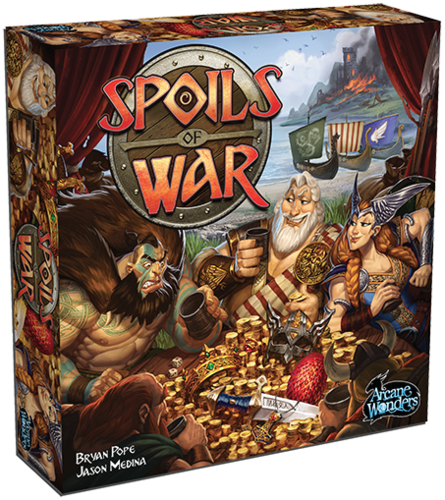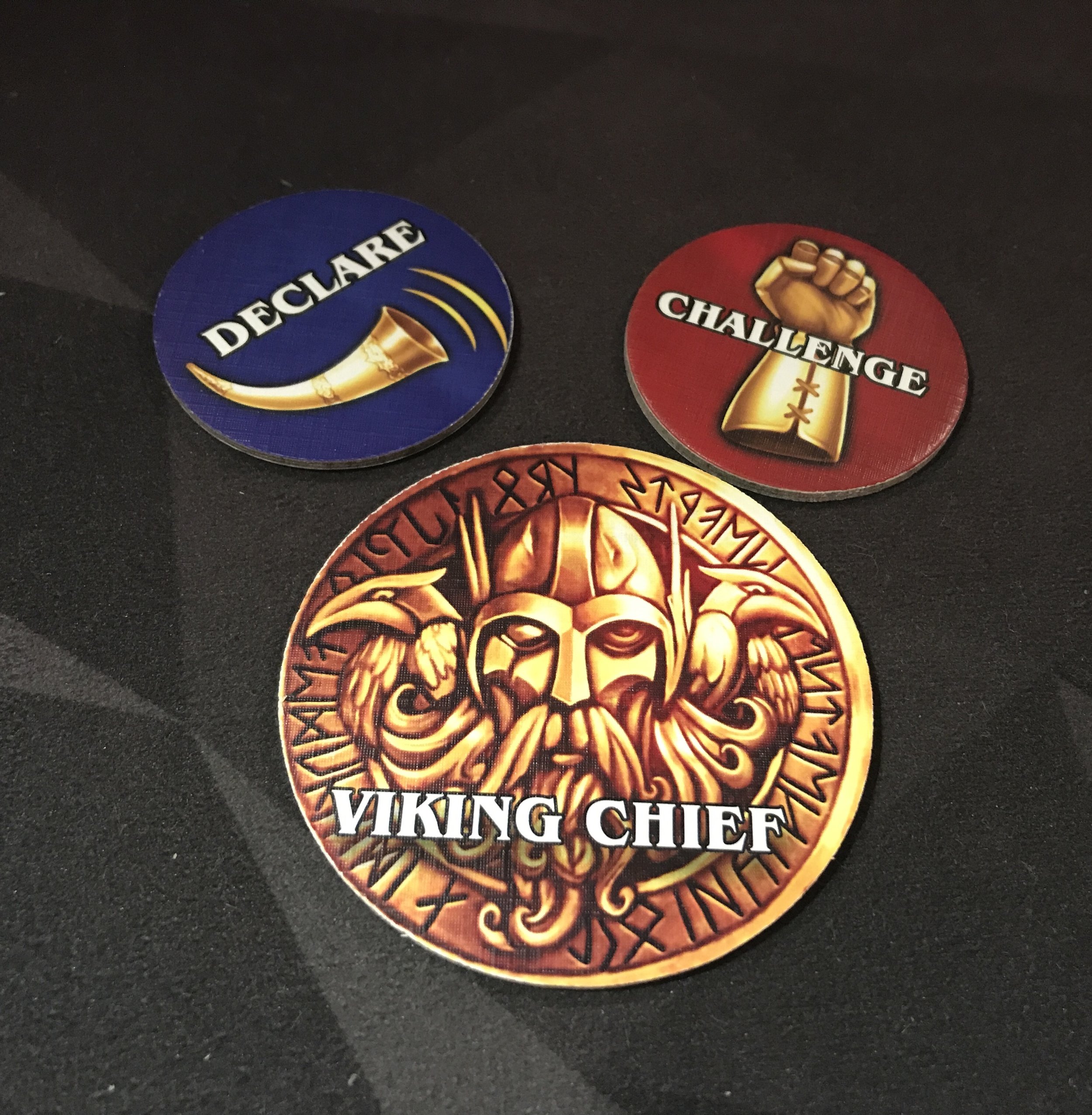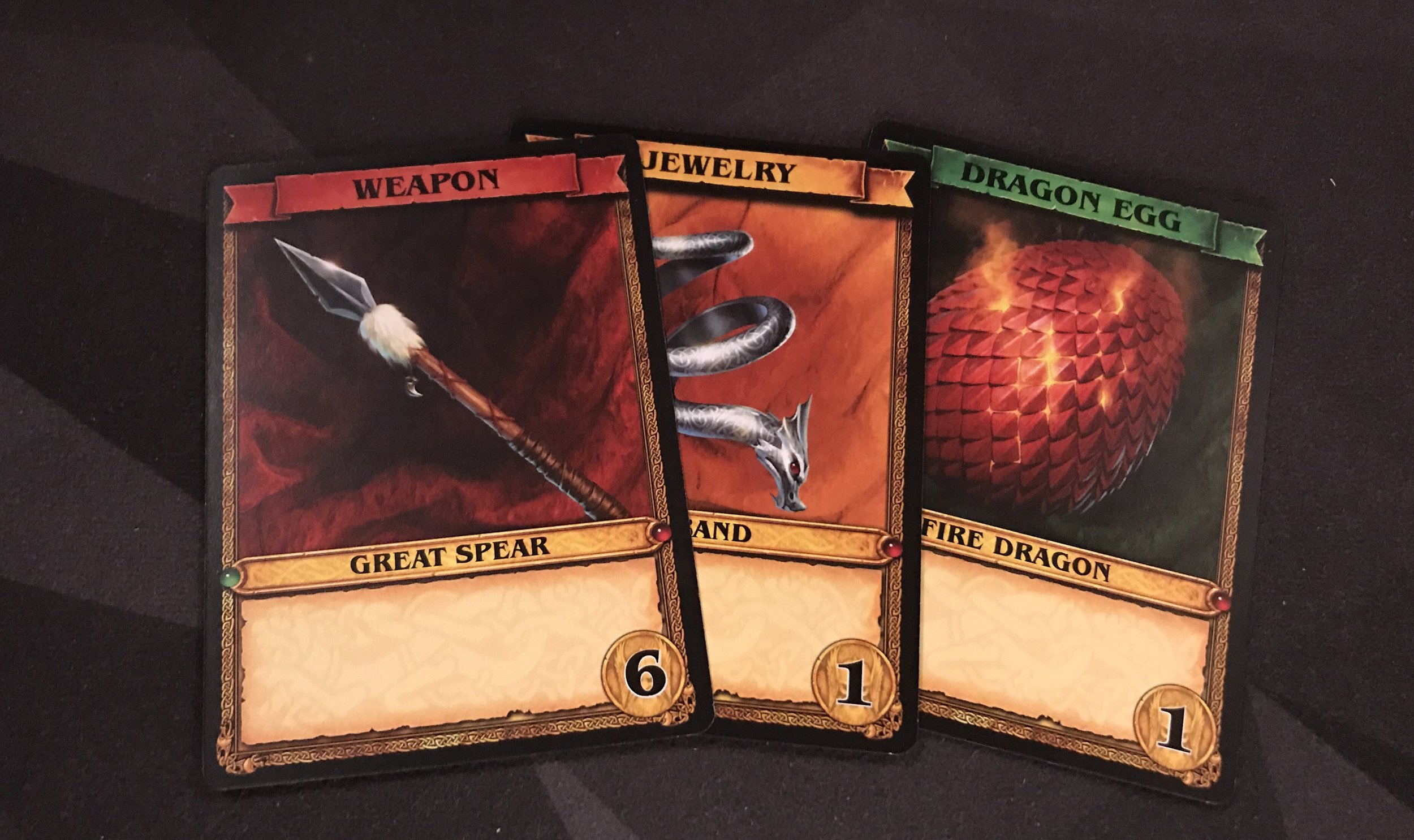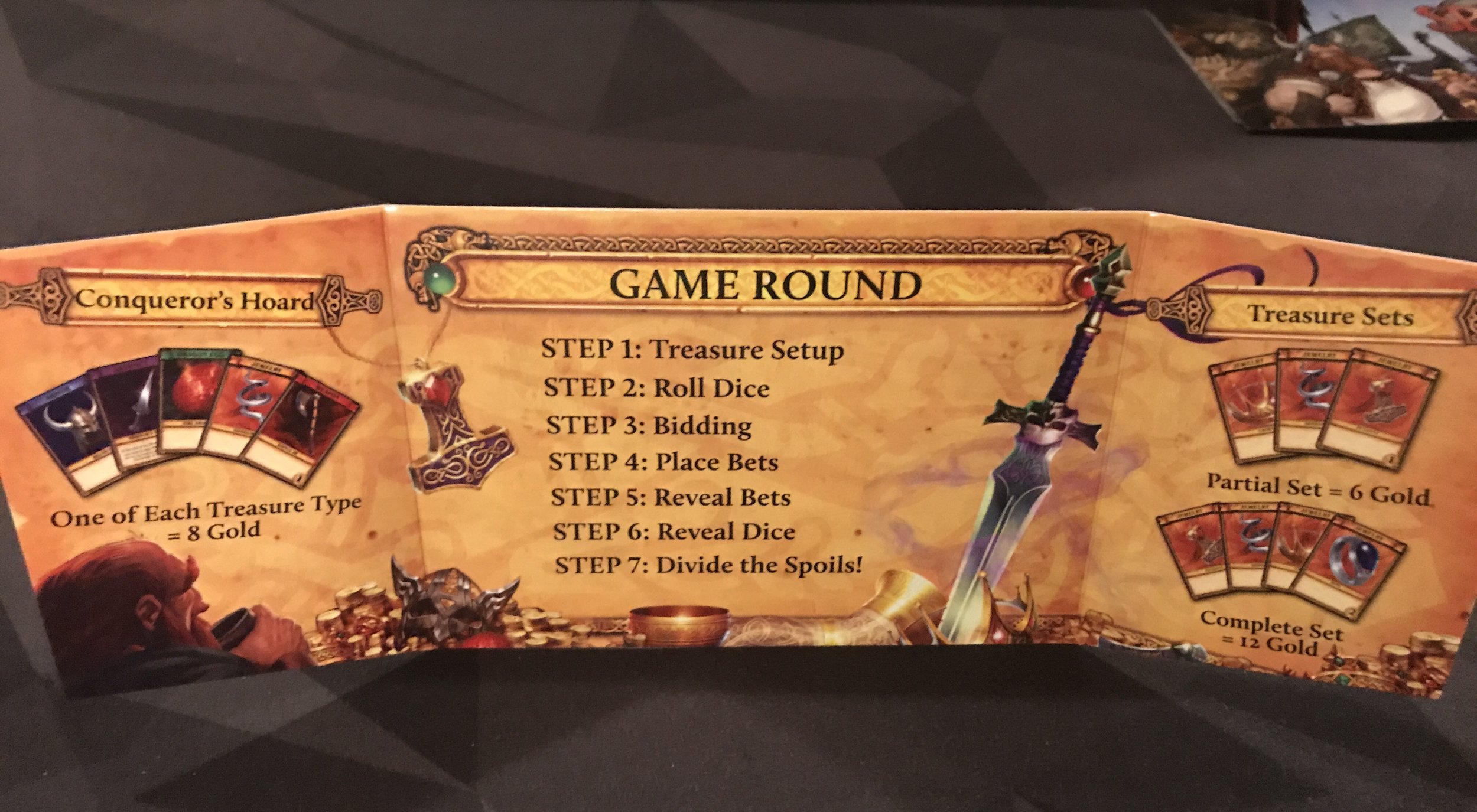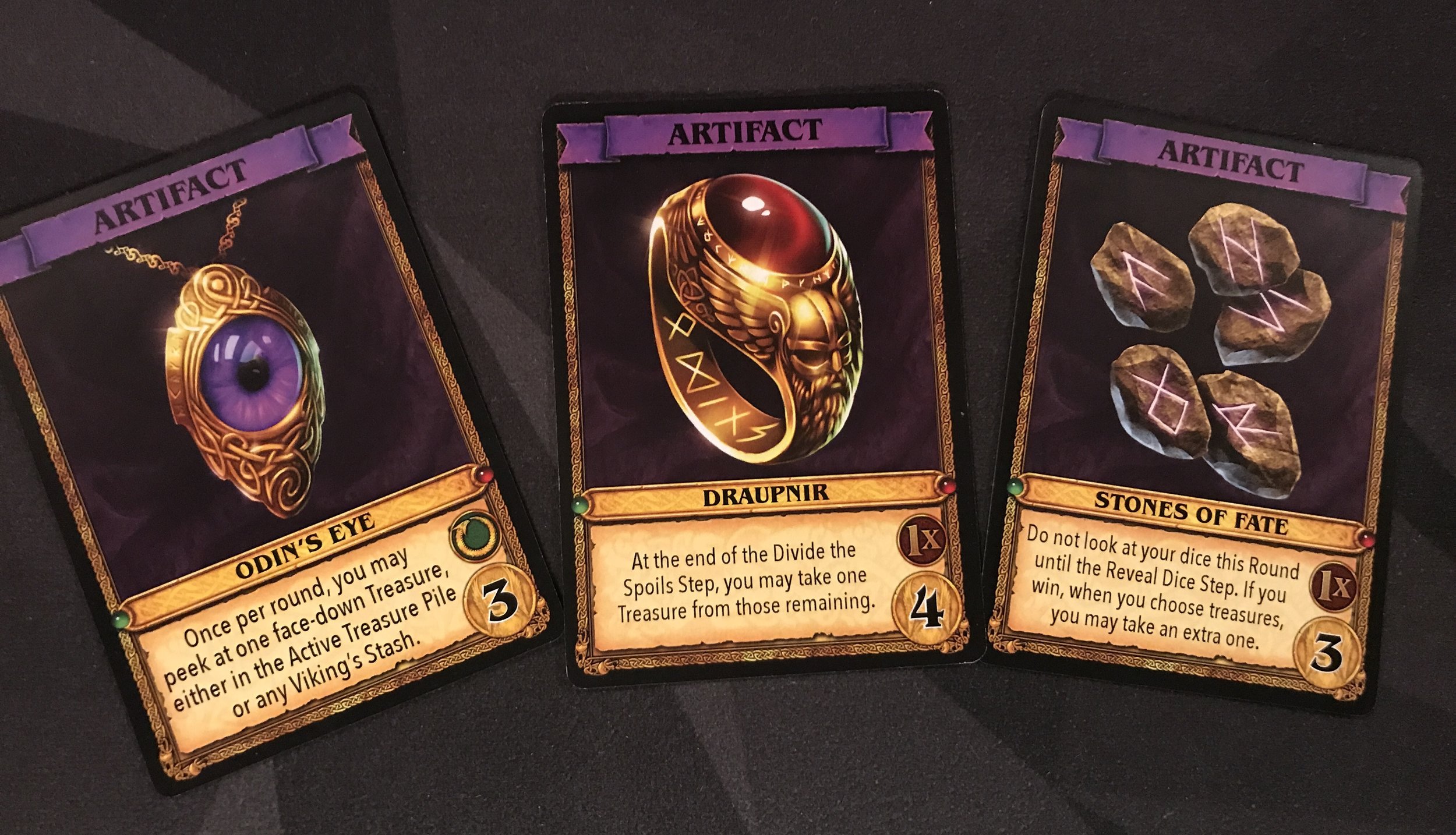My Cup Runneth Over--A Double-Take Review of Spoils of War
/Liar’s Dice is a classic nongamer game. It’s easy to play. It’s portable. And it’s always fun--well, until you’re eliminated. But it’s short so even that doesn’t detract. Today’s review is Spoils of War by publisher Arcane Wonders and designers Jason Medina and Bryan Pope. It’s Liar’s Dice, but with set collection and bidding smooshed onto it. It’s pretty audacious to mess with a classic, so did Arcane Wonders roll the dice one too many times, or does our cup runneth over? Let’s find out!
The Components
- 126 Treasure Cards: Five different types (Armor, Artifacts, Dragon Eggs, Jewelry, and Weapons), and four different items within each type. Each card also has a Gold value on it.
- 1 Viking Chief token
- 35 dice
- 5 player dice cups
- 5 player screens
- 93 Gold coins in three different denominations
- 5 Betting discs, each with a blue Declare side and a red Challenger side
- 4 markers to denote various states that can come up in a game
The Setup
Choose a starting player, and give that player the Viking Chief token. Each player takes a dice cup, a screen, a Betting disc, 70 starting Gold, and a number of dice depending on the number of players.
The Treasure cards are divided into 1, 2, and 3 decks (with numbers on the back). Take each of those decks, shuffle them up, and create three equal piles of a certain number of cards, again, depending on the number of players. After doing that for each of the three decks, you’ll have nine piles of facedown cards--three 1s, three 2s, and three 3s--lined up in a row. These act as a game timer, too.
The Gameplay
Each of the game’s nine turns has the same seven steps. (Don’t worry...some are very short.)
Step 1: Treasure Setup
The current Viking Chief takes the leftmost pile of Treasure cards and turns up all of the regular Treasure cards and keeps Artifact cards facedown. (Artifact cards have a crystal ball on the back, so you can easily spot them and keep them facedown.) Then group the same type of Treasures together for ease, making sure everyone can see what the items are, and how much Gold they’re worth.
Step 2: Roll Dice
This is easy. Put your dice in the cup. Shake the cup. Put the cup down on the table. Look at your dice, using the cup to keep them hidden from other players.
Step 3: Bidding
The Viking Chief chooses which player will begin the bidding, and that player makes a bid. He announces a quantity of dice and a value of dice that he thinks are in the game among all of the dice among all of the players. So he might say “Six 5s,” or “Eight 3s.” That means that he thinks there are eight dice among all of the players’ dice that have a value of 3. (Unlike Liar’s Dice, there are no wilds here.) You can, of course, bluff in order to throw off people who come after you. Each subsequent player must either increase the last bid, or challenge. And increase means he must either name a larger number of dice and/or a larger value on the dice. So if the previous bid is “six 5s,” a higher bid could be “seven 5s,” or “six 6s.”
If you think the previous bid is incorrect, you can Challenge. You take your Betting disc and place the red Challenger side up, and the person who had the previous bid places his disc with the blue Declare side up. That ends the Bidding phase.
Step 4: Place Bets
Everyone secretly and behind their screens decides which player they think is correct by placing their Betting disc with the corresponding side faceup. Each player also places a Gold bet on top of the disc, and you must bid at least 5 Gold, as long as you have it. (If you don’t have 5 Gold, you must bid all you have, and then you’ll pick last when it comes to getting Treasure later.)
Step 5: Reveal Bets
Once everyone has picked sides and placed bets, everyone reveals at once.
Step 6: Reveal Dice
Everyone reveals how many of the named dice they actually have. Determine whether the Declarer or the Challenger was correct.
Step 7: Divide the Spoils
First, any Vikings who were on the losing side put the Gold they bet into the bank. Those who were on the correct side keep their Gold.
Next, the player on the winning side who bet the most Gold becomes the new Viking Chief. (Ties are broken by the player sitting closest to the winning Declarer or Challenger, going clockwise.)
Now the new Viking Chief gets to pick three Treasures, and every other Viking on the winning side gets to pick two Treasures. The order of picking is again based on who bet the most Gold, and ties are broken going clockwise from the new Viking Chief. You can choose any of the available faceup Treasures, or take a chance on a facedown Artifact. As you move through the numbered decks, the Treasures get more valuable, as do the Artifacts.
Artifacts give you either a one-time bonus, or an ongoing power. They’re fun and crazy, and insert a lot of chaos into the game. One lets you look at another player's bid every round. Another lets you grab one of the leftover Treasures on the table. Another cancels another Artifact's power. It's bashy, but still fun.
When you play the Artifact, it’s still part of your Stash, so will still count for bonuses at the end of the game.
There are two bonuses. The first is the Conqueror’s Hoard, which is a set of all five types of Treasures. You get a bonus 8 Gold for each set of them.
The other bonus is Treasure Sets. If you have three different items of the same type, you have a partial set, which is worth 6 Gold. If you get four different kinds of the same type, you get 12 Gold.
After nine rounds, you count up leftover Gold coins, Gold values on your Treasures, and any bonuses you have. The winner is the person with the most Gold after all that.
The Verdict
Firestone--I wasn’t sure what to think about a classic that someone had “messed with.” But the truth is that Spoils of War adds fun stuff to this classic. The whole mechanism of other players betting on the outcome of the Challenge is simple and super clever.
Jeremiah--First of all... *ahem* I told you, you would like it! It adds just enough to make it interesting, and different, and of course no player elimination keeps it fun for all involved. I first played this at Origins, and LOVED it right away!
Firestone--Those Artifacts are nuts. They’re unbalanced, and add a ton of chaos and randomness to the mix. Still, the fun factor is so high on this one that I’m totally fine with it.
Jeremiah--Yep, don't take this game so seriously, and everyone will be juuuuust fine! The Artifacts are nuts, but the sooner you embrace them, the sooner you will wield unbelievable power!! Ha. Seriously, the first time I played I never really did much with the Artifacts I just went after regular Treasure. Big mistake! Being able to alter dice, see other players' bids etc. makes a HUGE difference in the game, and I paid dearly for my short-sightedness.
Firestone--My one complaint is that games go a little long. I consider Liar’s Dice to be a filler, and this is close enough to it that it just doesn’t seem like it should be any longer than a filler. But it is. Another group was waiting for us to finish so we could all figure out what to play next, and I felt like I was in a Seinfeld episode: "It'll be about 5, 10 minutes..."
Jeremiah--I can agree with that, but I never felt like it overstayed its welcome. I would also add, that the box says 3 players is a minimum, but I would recommend 4 players as a minimum with this one. Just seems to play a touch better with bidding, bluffing etc.
Firestone--Yeah, 3 players just isn't enough to make this interesting. The more the merrier.
I should note that, while I think this will be a GO-TO game for the family, and at the holidays and so forth, it was just a biiiit too much for my 9-year-old. He had a hard time bidding accurately, and was often either way under (which is okay), or way over (which creates problems). Still, this is solid family fare.
But our gamer group loved it, too. We had a ton of laughs playing this. Mostly due to those nutso Artifacts, but it was also just a good time. It's why I play board games.
Jeremiah’s Final Verdict--I loved this game from the get-go! It's solid, clever fun, with delicious player interaction and lots of ways to mitigate dice rolls! Spoils of War has earned a spot on my shelf!
Firestone’s Final Verdict--Other than in super-specific situations, I have no idea why I would ever play regular Liar’s Dice, now that Spoils of War exists. It’s fun. It’s clever. And I can see this coming out for years to come.
Theology of Games would like to thank Arcane Wonders for providing review copies of Spoils of War. This in no way affected our opinions of the game.
Thanks for reading!

